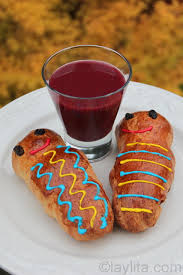The informant is a 19 year old Ecuadorian student studying Architecture at the University of Southern California. Her family is from Quito, Ecuador and she grew up there. She moved to Southern California in early 2015 to go to college.
“We have in the Day of the Dead, we have a custom of making these dolls out of bread and like decorating them and making this delicious like, its called “colada morada”. And the bread dolls are called “guaguas de pan”. “Guaguas” is a Quichua word that means children – “Children of Bread”. And then the drink is called “colada morada” because it is this mix of different berries and stuff like that and it looks purple.
“At the beginning, it was for the indigenous tradition in which they made these things to represent the blood and the body of their dead relatives. They went to the cemeteries and ate them, and ate it there in the tombs with all the family. But now they don’t normally take it into the cemeteries, they just like sell it everywhere. All families always come together for colada morada and guaguas de pan and it’s something that the children make, and it’s really nice. It’s really pretty.”
The informant said that she made guaguas de pan when she was little and said, “Since you are little you always do it and in school it’s really typical”
Images:

photo from: laylita.com found here
Analysis:
As the informant explained, this tradition has its roots in indigenous traditions. These “bread babies” and the purple drink were supposed to represent deceased relatives. Similarly to “Dia de los muertos” traditions in other countries, there is an object that represents or memorializes a loved one. In other cultures, it is often an image of the loved one. In this case, it is a food item. This adds several symbolic elements to the commemoration of the loved one: 1. Making the commemorative item is a family event where children, who may not even have known the deceased, participate. This emphasizes that both the dead family and living family members are important and time with the living should be treasured. 2. The memory of our deceased loved ones literally sustains us. We can grow and be sustained by their remembered lives and wisdom. 3. Shows that life is perishable. They do not have a photograph or image of a loved one, which could last forever, past when everyone who knew the person is dead. Instead they commemorate the dead with something that is perishable (bread) and will not last forever, just as their life did not last forever.
Now that the element of eating this food at the graveside is no longer present, this custom has become more of a living-family building event and some of its other elements have been reduced in importance. The fact that it is beautiful and that an effort is made to make them beautiful adds the element that, even through sadness and loss, bits of beauty and happiness can be found and should be sought after.
